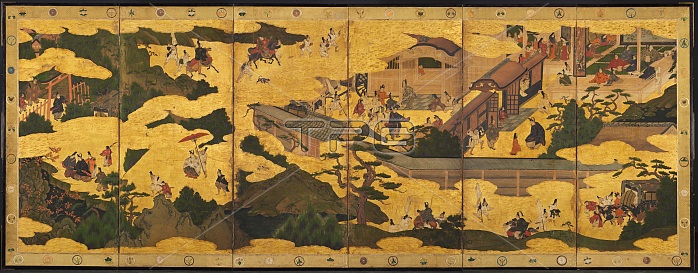
Scenes from the "Tales of Ise", mid-1600s. While the 11th century Tale of Genji is universally regarded as Japan's literary masterpiece, the source for visual imagery in Japanese culture is rivaled by another literary classic, the Tales of Ise . A 10th century anthology of poems interspersed with commentary, the Ise portrays the emotional and geographical journey of a courtier from the capital (Kyoto) into the countryside and beyond. The poems describe features of the natural, untamed terrain, linking them to the rather melancholy state of the traveler. Since the Tales of Ise was?and remains today?well read by educated Japanese, a person viewing these folding screens would immediately recognize its subject, organized as a series of discrete scenes read from right to left. Neither a signature nor a seal identifies the artist, but judging from related paintings, the work can be ascribed to an artist working in Kyoto during the first quarter of the 17th century in the manner of the painter Iwasa Matabei (1578-1650). This type of historical narrative composition became quite popular around 1600 among patrons favoring a distinctly Japanese style of painting which employed rich mineral pigments and a liberal use of gold.
| px | px | dpi | = | cm | x | cm | = | MB |
Details
Creative#:
TOP25298159
Source:
達志影像
Authorization Type:
RM
Release Information:
須由TPG 完整授權
Model Release:
No
Property Release:
No
Right to Privacy:
No
Same folder images:

 Loading
Loading